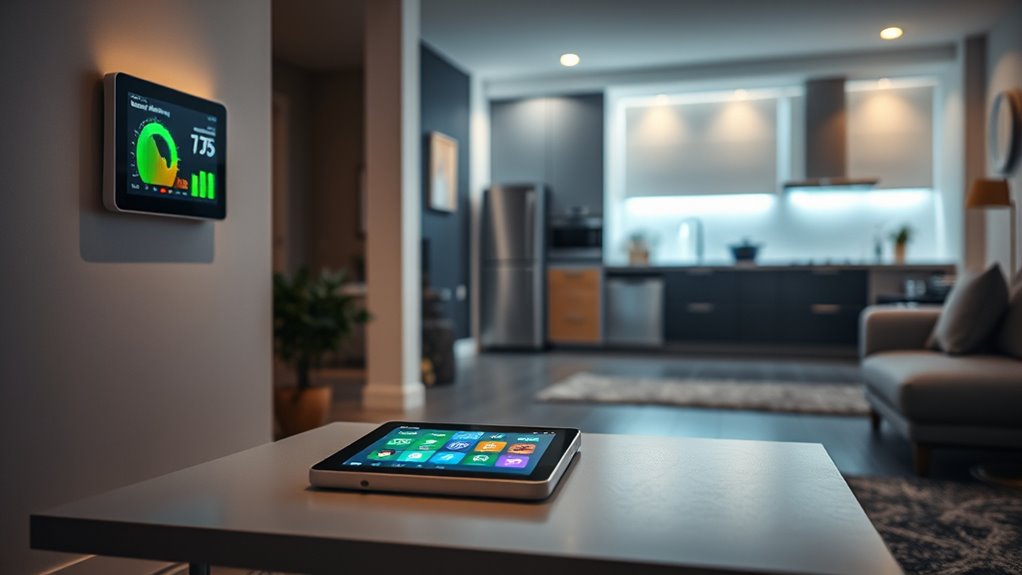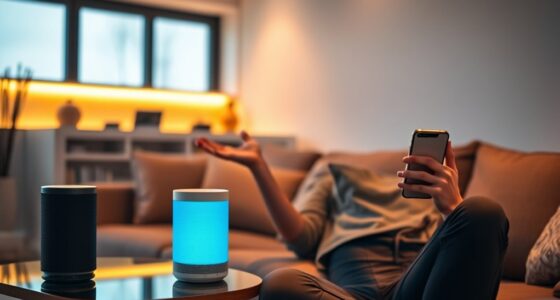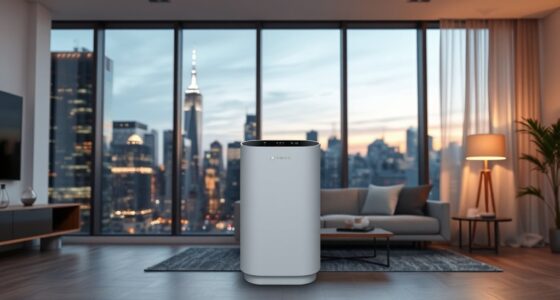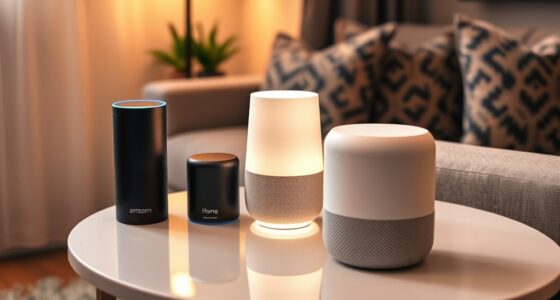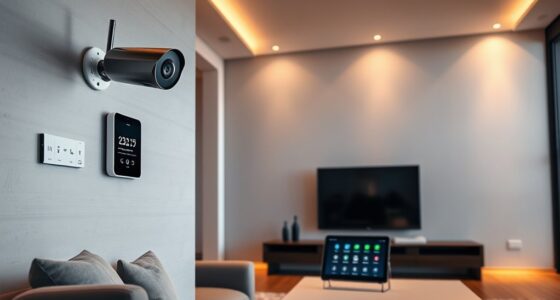Smart home energy monitoring helps you track your electricity use in real time, so you can identify wasted power and optimize your appliances. With devices like Emporia Vue 3, you can see how much energy your home consumes, spot high-usage appliances, and find phantom loads. These tools also allow remote control and detailed data analysis. Keep exploring to discover how choosing the right monitor can maximize your savings and boost efficiency in your home.
Key Takeaways
- Monitor real-time energy consumption across your entire home or specific circuits via smart energy monitors.
- Use apps to access detailed hourly, daily, and monthly energy data remotely.
- Identify high-energy appliances and phantom loads with up to 97% accuracy for targeted savings.
- Detect faulty or inefficient devices to optimize energy use and reduce costs.
- Integrate with smart home systems for automated management and notifications on energy usage.
Understanding Home Energy Monitoring and Its Benefits
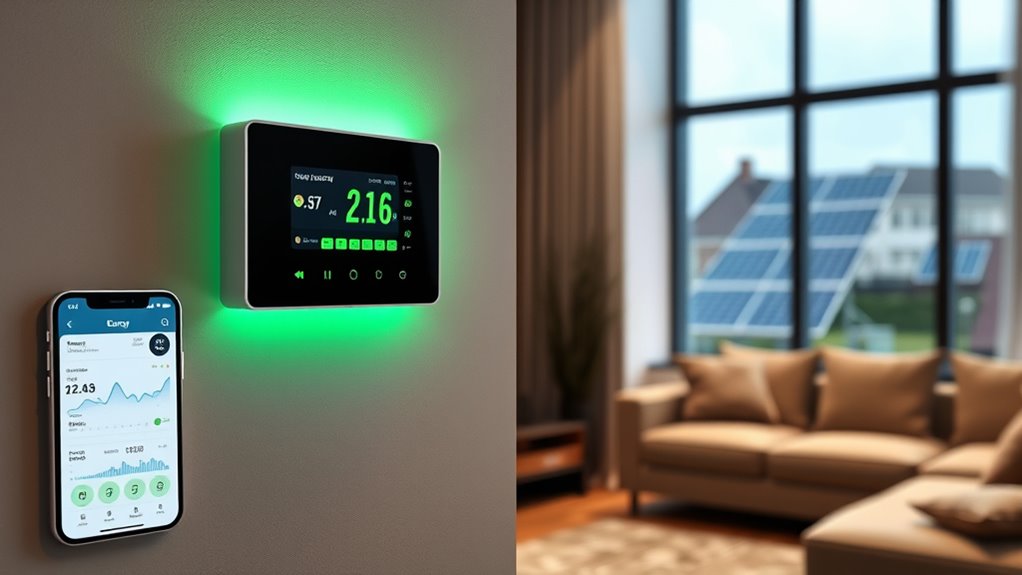
Have you ever wondered how much energy your home actually uses and where it all goes? Home energy monitors give you that clarity by tracking your energy usage and displaying real-time energy consumption. They can also help you identify energy efficiency opportunities, enabling you to make smarter choices about your home’s energy use. With these devices, you can identify appliances by their electrical signatures, often with 97% accuracy, helping you target specific devices for energy-saving efforts. They also provide detailed insights like hourly, daily, and monthly data, so you can spot high-energy appliances and peak usage times. Additionally, many monitors incorporate performance cookies that collect data to optimize the device’s functionality and your experience. Many home energy monitors support smart app integration, allowing you to access data remotely, receive notifications, and automate energy-saving routines. Understanding renewable energy technologies can help you further reduce your carbon footprint and enhance your home’s sustainability. Incorporating home automation systems can further streamline your energy management, making it easier to maintain efficiency. Using a monitor can lead to savings of up to 8% on your electricity bills and encourage more conscious energy consumption habits.
Exploring How the Emporia Vue 3 Works
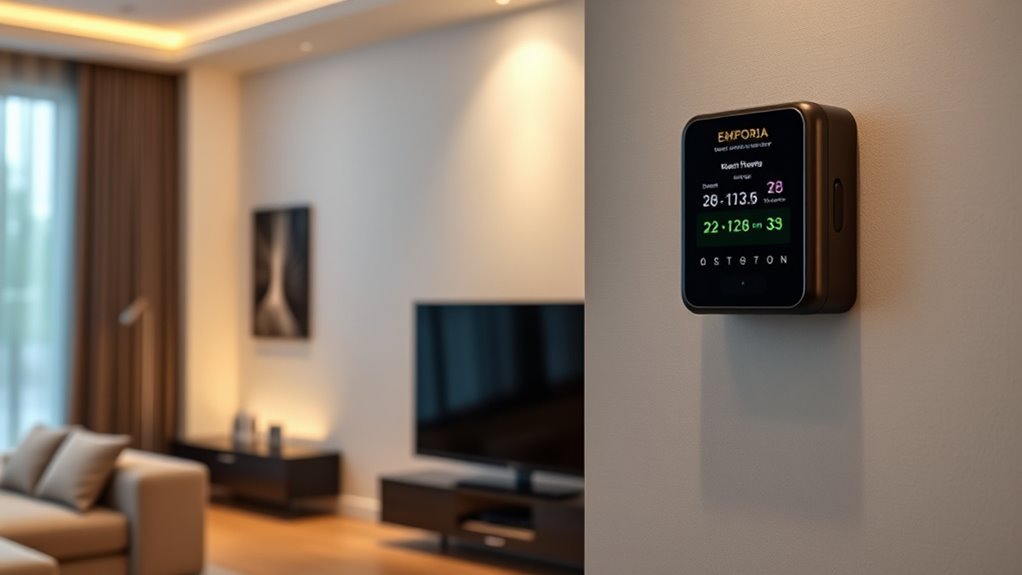
The Emporia Vue 3 works by integrating directly into your home’s electrical panel to monitor energy consumption across the entire system or specific circuits. It uses clamp-on sensors to measure current on various circuits, supporting systems up to 3 x 200A mains and 16 branch circuits. These clamp-on CT sensors are rated up to 200A and designed to fit standard wires, providing accurate energy monitoring. The Vue 3 connects to your Wi-Fi via the 2.4 GHz band or Ethernet, enabling real-time data access through mobile and web apps. This setup allows you to see your home energy use instantly and analyze historical trends. With its precise circuit monitoring, you get a clear picture of where and how your energy is being consumed, helping you make smarter energy choices. Understanding your energy consumption patterns can further enhance your ability to optimize home efficiency and reduce costs. Additionally, the Vue 3’s detailed insights can support home automation efforts by providing data that can trigger energy-saving actions. Incorporating smart home integrations can further streamline your energy management.
Installing and Setting Up Your Energy Monitoring System
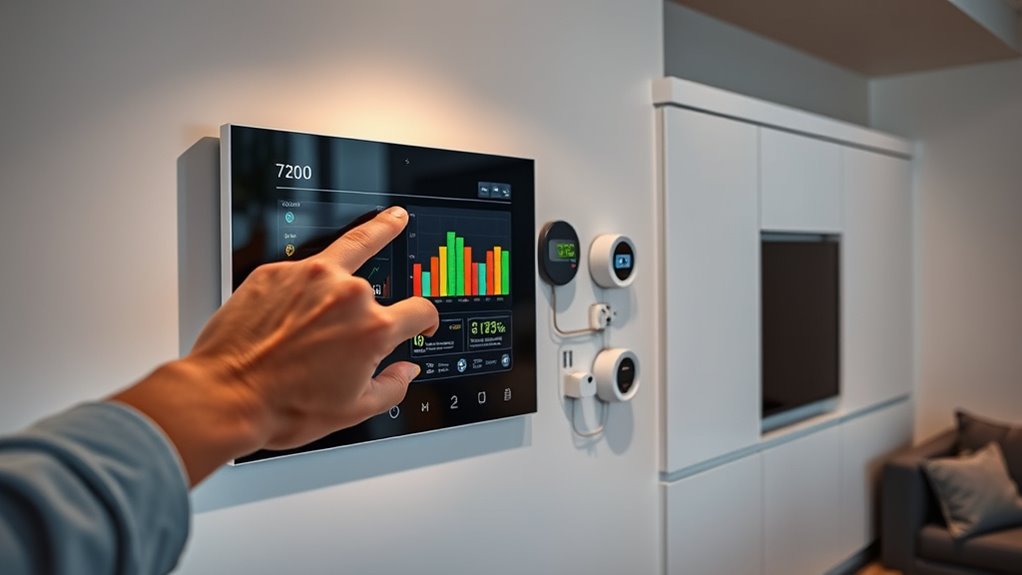
Installing and setting up your energy monitoring system requires careful attention to safety and proper wiring. First, you’ll need to access your electrical panel, where clamps must be attached around live wires—this step is best left to a professional to ensure safe installation. Make sure the antenna is positioned outside the metal panel for proper Wi-Fi connectivity, as the device supports only 2.4 GHz networks. During setup, connect the monitor via Bluetooth to the app, which guides you through wiring verification and Wi-Fi connection. Calibration involves turning circuits on or off to improve appliance detection accuracy, a process that may take several weeks. Remember to follow safety precautions, like using a voltage detector and working with one hand, to avoid risks during installation. Additionally, understanding the role of contrast ratio can help optimize your system’s performance and image quality. Proper placement of the monitor can also help in maximizing Wi-Fi signal strength, ensuring reliable data transmission. Incorporating proper circuit identification can further enhance the accuracy and efficiency of your energy monitoring. To ensure your system functions optimally, consider regular system maintenance and updates to address potential software bugs or connectivity issues. Being aware of special occasions or holidays can also help you plan system adjustments for optimal energy use during different times of the year.
Real-Time Data Tracking and Appliance Identification
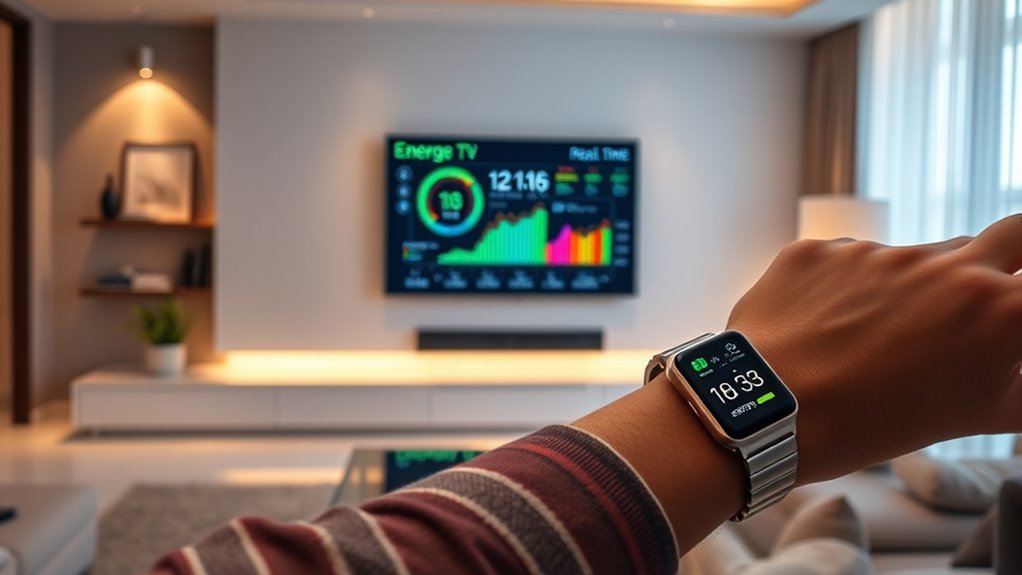
Real-time data tracking in home energy monitors analyzes electrical signals up to a million times per second, providing immediate insights into your household’s power usage. This continuous monitoring allows you to see current energy consumption instantly through your mobile app or web portal. Utilizing data-driven strategies can help you optimize your energy consumption patterns more effectively. Advanced systems like Sense can identify individual appliances by recognizing their unique electrical signatures, with confidence levels over 97%. Although appliance identification takes time to optimize, it learns your device patterns over weeks, improving accuracy. Incorporating Hyundai Tuning principles, such as precise calibration and system adjustments, can further enhance the accuracy of appliance detection and overall system performance. Proper calibration techniques, similar to electrical signature analysis, can significantly improve the system’s ability to distinguish between different devices. Regular system maintenance ensures sustained accuracy and optimal operation of your energy monitoring setup, aligning with best practices in personal development for continuous improvement.
Customer Experiences and Cost Savings Examples
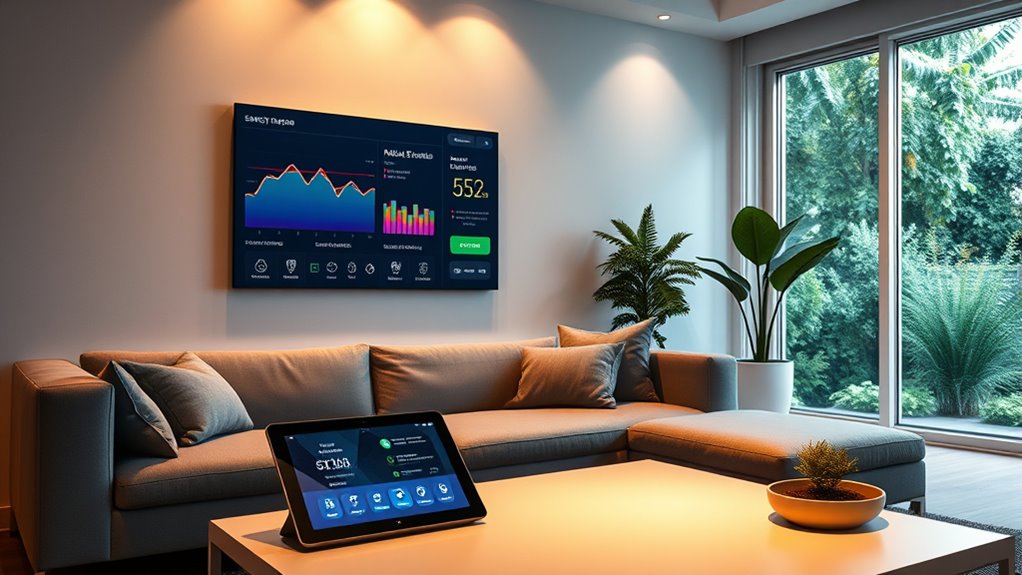
Many users have seen significant savings by identifying high-energy devices and making targeted changes. For example, some have cut their bills by hundreds of dollars after spotting inefficient appliances or faulty equipment. Utilizing paint sprayer accessories and proper maintenance can further optimize energy use and prolong equipment lifespan. Additionally, exploring best laundry detergents can improve washing efficiency and reduce the need for re-washing, ultimately saving energy and costs. These real-world experiences highlight how smart energy monitoring can lead to practical, measurable cost reductions. Engaging in remote hackathons can also foster innovative solutions for energy management systems and promote collaboration among developers seeking to improve sustainable technologies.
Notable Energy Savings
Customers have reported substantial energy savings after using home energy monitoring, with some saving up to $750 a year by identifying and fixing inefficient appliances. These notable energy savings showcase how smart devices can enhance your energy management and boost overall energy efficiency. Additionally, integrating natural language processing technology into monitoring systems can improve user interaction and make energy management more intuitive. For example, Howard S. saved $175 by switching to LEDs after detecting high usage through monitoring. JD G. cut about $80 off his bill within 15 minutes by discovering a faulty device. On average, users see around an 8% reduction in monthly bills, translating to significant cost savings over time. Home energy monitoring helps you uncover hidden power draws and optimize your household energy use, making it easier to reduce energy bills and improve your home’s payment security. Moreover, leveraging insights from AI security research can help in detecting unusual energy consumption patterns and protecting your smart home from cyber threats. Incorporating energy-efficient appliances further enhances savings and promotes sustainable consumption, while understanding your home’s energy profiles can help tailor more effective energy-saving strategies.
Identifying High-Use Appliances
By using energy monitors like Sense, homeowners have pinpointed high-use appliances that drive up their bills. These devices provide real-time data, making appliance identification straightforward. For example, recognizing a faulty water pump or inefficient furnace can lead to substantial energy savings—sometimes up to $750 annually. Monitoring also reveals phantom loads from TVs and chargers, which can be reduced by unplugging or upgrading. Here’s a snapshot of common high-use appliances:
| Appliance | Typical Power Draw | Savings Tip |
|---|---|---|
| HVAC System | High | Schedule regular maintenance |
| Water Pump | Moderate to High | Repair or replace as needed |
| Chargers & Devices | Low to Moderate | Unplug when inactive |
| Televisions | Moderate | Use smart power strips |
Identifying these appliances helps you adjust usage patterns for better energy savings.
Practical Cost Reduction
Using a smart energy monitor like Sense can lead to immediate and tangible savings. By tracking your energy usage, you’ll identify high-consuming appliances and phantom loads that inflate your home’s cost.
For example, users have reported saving up to $750 annually by fixing faulty equipment, like furnace relays. Replacing old bulbs with LEDs, as Howard S. did, cut his energy costs by $175.
Within just 15 minutes, JD G. pinpointed a device that was consuming excessive energy and reduced his bill by about $80.
Overall, households using energy monitors typically cut their electricity costs by 7-8%, making it easier to reduce your monthly bills and save money.
Tracking your home’s energy not only highlights savings but also helps you make smarter choices to lower your cost.
Choosing the Right Energy Monitor for Your Home
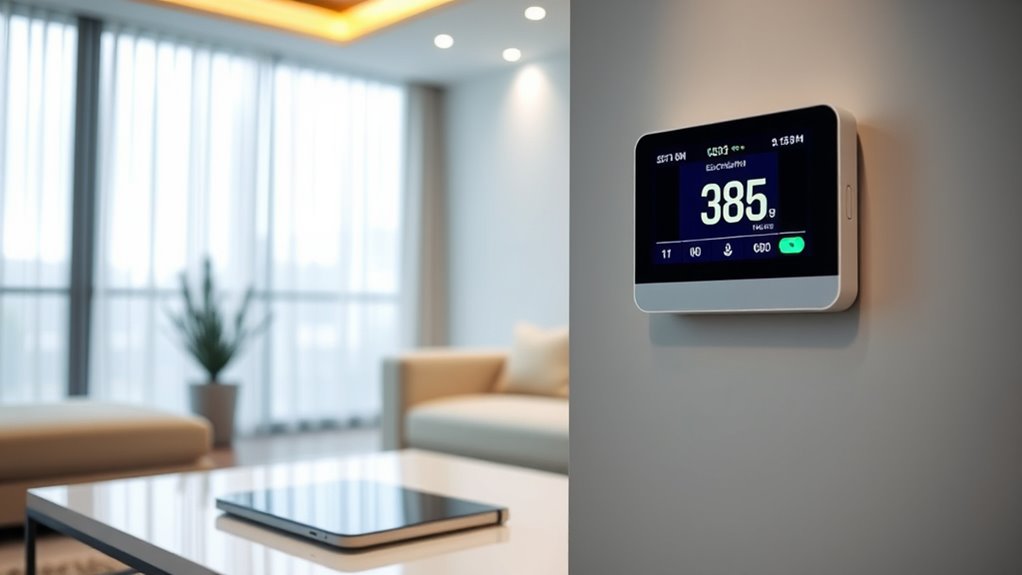
Choosing the right energy monitor starts with checking if it’s compatible with your home’s electrical system, whether single-phase or three-phase.
You’ll also want a device that’s easy to install and set up, ideally with professional assistance if needed.
Ensuring these factors match your setup helps you get accurate data and a smooth experience.
Compatibility With Electrical Systems
Ensuring your energy monitor is compatible with your home’s electrical system is essential for accurate readings and safe operation. Check that the device supports your electrical system’s voltage, whether it’s 110-120V or 220-240V.
Most homes in North America use single-phase systems, so verify the monitor is designed for single-phase or three-phase setups if applicable. Your wiring configuration matters too—verify the monitor supports your circuit type, such as 2-wire or multi-wire circuits.
Additionally, confirm it can handle your home’s amperage, typically up to 200A or more, to prevent overloads. Considering regional electrical standards and voltages helps avoid compatibility issues and ensures safe, reliable performance of your energy monitor.
Installation and Setup Ease
Selecting the right energy monitor for your home involves considering how easy it is to install and set up. Many devices, like Sense and Emporia Vue, require professional help because of live wiring and safety concerns. Compatibility with your electrical panel is vital; some monitors work well with standard North American systems, but others may face issues with regional wiring. Devices with plug-in sensors or external clamps can simplify installation but might limit data detail. To help you visualize, here’s a comparison:
| Feature | Details |
|---|---|
| Installation complexity | Professional help often needed for safety and accuracy |
| Compatibility | Confirm device matches your electrical system |
| Setup process | Some devices offer quick, plug-in options |
| Safety considerations | Proper installation minimizes electrical hazards |
| Regional restrictions | Verify device suitability for your location |
Choosing a monitor with straightforward setup and proper professional help guarantees safe, effective installation.
Frequently Asked Questions
How Do I Track My Energy Consumption?
To track your energy consumption, you can install a smart energy monitor in your electrical panel. It analyzes the electrical signals in real-time and sends data to your mobile device via WiFi.
You’ll see detailed insights into your overall usage, specific appliances, and patterns over time. Use the app’s graphs and reports to identify wasteful devices and make smarter choices to reduce your energy bills.
Can I Monitor My Energy Usage on My Phone?
While it might seem complicated, monitoring your energy usage on your phone is actually straightforward. Modern energy monitors like Sense and Emporia Vue connect seamlessly to your Wi-Fi or Bluetooth, sending real-time data directly to their apps.
You can check your consumption anytime, anywhere. These apps not only display your overall usage but also identify specific appliances, helping you make smarter energy choices with just a few taps on your device.
How Can I Check My Daily Usage of Electricity?
To check your daily electricity usage, open your home energy monitor’s app on your smartphone.
Look for the daily or 24-hour report, which shows your consumption in kilowatt-hours.
Review the graphs and data provided, and compare different days to spot patterns or spikes.
Many monitors automatically recognize appliances, so you can see which devices use the most energy.
Regular checks help you save by managing high-energy appliances better.
How to Record Energy Consumption?
Imagine uncovering the hidden patterns of your home’s energy use—it’s easier than you think.
To record your consumption, you connect a home energy monitor like Sense or Emporia Vue to your electrical panel. These devices capture real-time data, which you access through their apps.
Regularly review these reports, set alerts for unusual activity, and watch your energy habits transform.
Now, you hold the power to understand every watt you use.
Conclusion
By monitoring your energy use, you could cut your bills by up to 20%, making your home more efficient and eco-friendly. The Emporia Vue 3 makes it easy to see exactly where your energy goes, helping you make smarter choices. With real-time data and appliance identification, you’ll stay in control of your consumption. Start tracking today, and turn your home into a smarter, more savings-oriented space!
